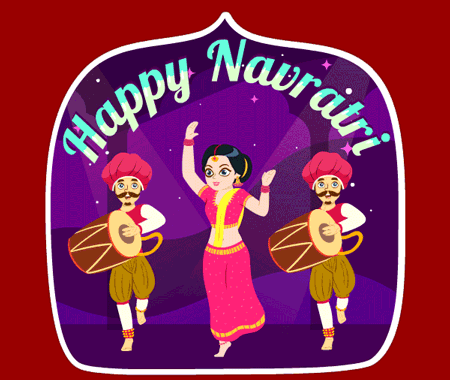Sri Sri Ravi Shankar on Navratri:
‘Nava’ means ‘nine’ and ‘Ratri’ is made up of ‘Ra’ which also means ‘night’ and ‘Tri’ meaning the ‘the three aspects of our life, Body, Mind and Soul. So ‘Navaratri’ means ‘giving rest to all the three aspects of our life, for nine days’.
The first three days of Navaratri, are ‘Tamasic’ days, followed by three ‘Rajasic’ days and ending with three ‘Sattvic’ days. At night all the artis are performed for the Devi – the enjoyer of everything. So there is classical dance, music and various musical instruments being played. Each day has special implications, yagnas, poojas and homas are performed.
Among the things offered to the fire are hundreds of different herbs, fruits, garments, and mantras, all creating a gloriously divine atmosphere to drown in? Our ancestors felt the inadequacy of words and so they expressed themselves with symbols … for instance, we offer flowers and fruit to God. The ‘flower’ is a symbol of what we are – so full, attractive and so light – so beautiful. Fruits are symbols of completeness. In the life cycle of a plant, fruits signify completeness.
Also the fruit is the ultimate result. That is how we feel when we offer the symbolic fruit to God with all the gratitude for contentment in life.
We also light lamps. Indian tradition involves tall brass lamps with a swan carved at the top.
This is a very beautiful symbol. It means that with the light of knowledge, one attains ‘Viveka’ a characteristic of the swan. In Sanskrit, it is called ‘Neerakshiraviveka’ meaning a swan can differentiate between milk and water even though both may be mixed. Similarly, in the context of Navaratri, there is a symbolism behind the ‘bull’ being destroyed by the ‘Devi’.
What do we call someone who is very dull, thick skinned and insensitive? A buffalo! Only the Mother Divine can destroy this buffalo with the collective energy of Brahma, Vishnu and Mahesh! Just as a baby takes nine months to be born, the Devi took nine days to rest and what was born on the tenth day was pure love and devotion, with which the Devi conquered the buffalo of inertia and dullness! Devi Ma is not somebody holding a big ‘trishool’ in one hand.
She is a form of energy, a manifestation of the Divine itself. Therefore, sometimes, the forms taken by this Divine may be that of Ganesha, Chandi (Devi), Vishnu, Shiva….. and the manifestation, in this creation, happens in a mother’s womb…. in silence, secretly. So during these nine days of Navaratri when the Master goes into silence, the energy is in the process of getting more and more refined, well-tuned, to welcome the Mother Divine. This is called ‘Aradhana’. Now these yagnas are not for the sages who perform them, but for the entire Universe for all the misery, sorrow, and pain in the world. The blessings of the yagnas and poojas teach the whole of humanity and a lot of good comes out of these – peace, strength, prosperity, success and faith – which by itself, is the best blessing. Gurudev says that the ninth day is a day for honouring everything that we have, no matter how seemingly insignificant, and the tenth day is ‘Vijaya Dashmi’ the ‘victory day’. It is only after we have honoured something that we can gain victory over it. This day is celebrated as the victory of the Devi over the evil forces – which is also just ‘Maya’.
As we take nine months in our mother’s womb, before we are born, we take these nine days to go back to our source. These nine days are to be spent in meditation, satsangs, silence and knowledge. During this period, the first three days are of the Kaali, the Adhishthata (the Authority) of Tamo Guna, the next three days are of Mahalakshmi, the Adhishthata of RajoGuna and the last three days are of Saraswati, the Adhishthata of Sata Guna.
And when we move from Tamo through to Satva, the Victory happens; victory over our own devilish tendencies, like RaagDvesh (cravings-aversions), Raktabijakshur (inherent ‘tendencies in our DNA.: which can be changed ,only through satsang) and Dhumralochan (the laziness of Mahishasur, the bull; one who’s eyes are clouded with small-mindedness)
Upavaas (what is normally understood as Fasting) actually means ‘sitting close’; close to the Guru. And when you are close to the Guru, the Self, you are in so much bliss, that you forget to eat or drink! You don’t feel Hungry or thirsty. And now that has become a false notion about’ Upavaas’. We relate it to fasting. It is good, to fast once in a while, for a day or two. However, it is not worth eating fried foods in the name of Upavaas (Saboodana wada, fried potato, etc). Eat fruits. The main thing is to listen to the body. Give it a break from the daily grind of digesting three meals, etc. When you attend to the body and it is rested, the mind also becomes peaceful. You do not have to fast to please GOD. Do it to purify your body and mind. Observing silence is also good. Everyone need not observe silence, avoid useless talks. Ardha Maun (partial-silence) is fine. Keep silence with a smile and Upavaas happens. At the end of the nine- day Aradhana, let there be newness in us.
Amazon #ads

Nav also means new. These are nine new nights. Krishna used to do a lot of Devi Pujas during Navaratri. He said; “I take a dip in my own Prakruti(nature), and come out to create new”. So, take a dip in your own nature and come out fresh and new. The more we go deep within ourselves, the more this Creation rejoices in celebration. These Yagnas have all the aspects of life so beautifully covered within them. It comprises of dance, music, food, celebration and everything. Not a single aspect of life has been left out. So, be within yourself during these nine days. Do not let any complaints happen.
Complaints drag you out; keep you rooted in the mud outside. Drop it all with a smile and go within. The diverse aspects of the Holy” Spirit are invoked during, these nine days. And like the nine months of formation spent in the womb, spend these nine days within and form a new spirit.
Then all the bad karmas and impressions are washed away. Navaratri purifies the individual consciousness and then the universal consciousness, the creation.
Navaratri means nine nights and the new night. Creation happens in darkness, in the womb of the mother and underneath the soil. Nine months in the womb are like nine long nights where the spirit takes human form
Night provides rejuvenation and rest. People come home from work at night and celebrate, rejoice, and pray. At night, the entire creation goes to sleep, including the Ashram night watchman
These nine nights of Navaratri are precious; they are enriched with subtle energy. Sixty-four impulses of the Divine Mother govern the subtle creation and are responsible for restoring all earthly and spiritual benefits. These impulses are contained within one’s awakened consciousness. The nine nights of Navaratri are celebrated to rekindle those divine impulses and to renew the inner depth of our lives.
Cleanse your body and cleanse your soul.
Cleanse your body with water;
Cleanse your soul with Knowledge, pranayam, Sudarshan Kriya, and meditation.
The Power of Devi Shakti
As the nine sacred nights of Navratri arrive, each nook and corner of the Ashram reverberates with the glory of its Dweller. And as Gurudev goes in silence, the space around echoes the unsung song of Divine Love.
Navratri is celebrated to honour the creation and rekindle the impulses of the Mother Divine contained in our consciousness. There are 64 impulses that govern the entire creation. Nights signify darkness. Creation takes place in darkness, like in the mother’s womb. The nine month’s in the mother’s womb are like nine long nights when the spirit takes the human form. Night also provides rest and rejuvenation and these nine nights represent eternal rest and freedom from bondage of the mind. This nine day period also has a great impact on the environment and surrounding. During the first three nights the energy is dominated by tamas, transforming to rajas during the next three and dominated by satva in the last three days.
The divinity is present in every atom of creation. This dormant divinity is enlivened through the process called yagya. The yagyas conducted during these nine days cover every aspect of the vast Vedic tradition. They are performed for the health, happiness and prosperity of all the people in the world, to nullify the negative karmas and create positive vibrations and celebration.
The yagyas begin with Ganesha Homa to clear all obstacles and hurdles. Navagraha Homa and Sudarshana Homa are performed before the grand Chandi Homa on Ashtami day. The most powerful of all Homas, the Chandi Homa covers 700 verses and 13 chapters of the Devi Mahatmaya. Through the yagyas the divinity is enlivened in the five elements, and in every possible thing in creation. The potency of the mantra is enlivened in our consciousness through various herbs, fruit and other substances which are all offered in the fire; and that shakti(energy) is transferred into the water in the kalash(the pot), which represents the Devi(Mother Divine).
The worshipper is Divine, the worship is Divine and the objects with which you worship are also Divine. During arati, all the species are represented, because all living beings are expressions of Shakti. Cows, elephants, children, couples – in everyone the Devi is recognized and invoked. Just as white light contains all the colours, so all the different aspects of divinity are of the nature of the self. The yagya thus is a prism through which the Self manifests.
Explaining the underlying meaning, Guruji once said, “During homas, Virupaksha is used in addressing the Divine. Virupa means formless and Aksha means eyes. So Virupaksha is one who is formless but can see everything. Our chetna or atma is like that. We perceive things through the senses, but it’s the consciousness that sees everything”.







